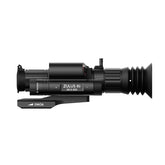Thermal vs. IR Night Vision Scope: Which is Right for You?
Choosing the right night vision technology can be confusing due to the many options available. The two most popular types are thermal imaging and infrared (IR) night vision. While both allow visibility in darkness, they work differently and have distinct advantages and ideal applications. Here’s a brief overview to guide your decision.
What is Thermal Imaging?
Thermal imaging detects the heat given off by objects. Everything, people, animals, and trees—emits heat. Thermal sensors pick up this heat and show it as an image, usually in shades of white, black, or colors representing different temperatures. The hotter an object is, the brighter it looks on a thermal image. This makes thermal imaging great for finding warm objects against cooler backgrounds, like spotting a deer in a field at night.
Pros of Thermal Imaging
- Works in Total Darkness: Since thermal sensors detect heat, they don’t need any light to work. This makes them perfect for complete darkness or low-light environments.
- Easily Detects Animals and People: Animals and humans stand out clearly against the cooler landscape, even if they’re hiding behind bushes or in shadows.
- Long Range: Thermal can detect heat from far away, making it effective for spotting animals or people at a distance.
- Obscured Views: Thermal can penetrate (to a degree) visual barriers such as smoke, fog, and light foliage cover, allowing for better target detection than is possible with just light-enhancement.
Cons of Thermal Imaging
- Lack of Detail: Thermal images don’t offer quite the same image clarity, so it can be harder to identify exactly what you’re seeing. For example, it might be easy to spot an animal, but hard to tell if it’s a coyote or a dog.
- Higher Cost: Thermal imaging devices tend to be more expensive than IR night vision devices, which can be a factor if you’re on a budget.
- Not Ideal for Close-Range Work: Thermal isn’t as effective for close-up observation. If you’re looking for something nearby, you might be better off with IR night vision.
- Cannot See Through Glass: Thermal devices can detect targets at a distance but may not provide positive identification. Performance can also be reduced by moisture, such as dense fog or rain.
Best Uses for Thermal Imaging
Thermal imaging is best suited for spotting animals or people at a distance. It’s ideal for hunting, search-and-rescue missions, and security applications, especially in conditions where total darkness or camouflage may hide targets.
What is IR Night Vision?
Infrared (IR) night vision technology works differently. Rather than detecting heat, IR night vision amplifies whatever ambient light is present in the environment (like starlight or moonlight) to create a visible image. In complete darkness, IR night vision devices use an infrared illuminator (torch) to shine light that is invisible to the human eye but visible to the device. This reflected light is what the device picks up, making the surroundings appear brighter and clearer.
Pros of IR Night Vision
- Detailed Images in Low Light: IR night vision provides a clear, detailed image, allowing you to see more specific features, like identifying the type of animal or person you’re observing.
- Works Well at Close Range: Because it shows finer detail, IR night vision is great for short- to medium-range applications, where you need to see clear features.
- More Affordable: IR devices are generally less expensive than thermal, making them a good choice for casual users or those on a budget.
Cons of IR Night Vision
- Requires Some Light (or an IR Illuminator): IR night vision works best in low light and may need an illuminator to work in complete darkness.
- Visible Glow from the Illuminator: Although the IR light itself isn’t visible to humans or animals, the device may emit a faint red glow, which can give away your position if you’re trying to stay hidden.
Best Uses for IR Night Vision
IR night vision is well-suited for short- to medium-range applications where identifying details is important. It’s a great choice for home security, close-range surveillance, and wildlife observation, especially in areas with some ambient light, like a backyard or near a campsite.
Choosing Between Thermal and IR Night Vision
When deciding between thermal and IR night vision, think about how you plan to use the device. Here’s a quick guide to help:
- Choose Thermal Imaging if: You need to detect the presence of people, animals, or warm objects over long distances in total darkness or hidden environments. Thermal is the best choice for hunting, nighttime exploration over large areas, and security monitoring where camouflaged or hidden objects may be a concern.
- Choose IR Night Vision if: You’re looking to see details at close range, especially in environments with some ambient light. IR night vision is great for observing wildlife, checking for activity around your property, or exploring places where you can be close to what you’re viewing.
Final Thoughts
Thermal imaging and infrared (IR) night vision offer unique advantages, depending on your needs. If you want to quickly spot a target from a distance, go for thermal imaging. For identifying details at closer range, choose IR night vision Scope.
Both technologies enhance nighttime visibility, making exploration and security easier. Choose wisely to maximize your nighttime adventures.
This is why we developed the ThermNight line of optics, giving the user an all-in-one unit that offers the widest range of use across multiple lighting conditions. Whether it’s pitch black, foggy, a wide open field, or underbrush, the ThermNight allows the user to scan for, locate, and positively identify their target by having both thermal and IR spectrums at their fingertips.











